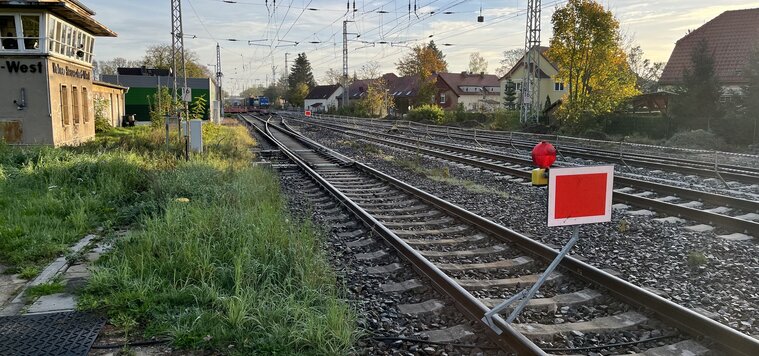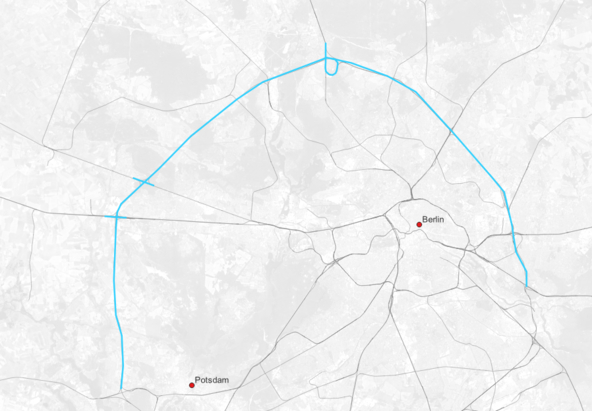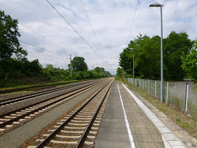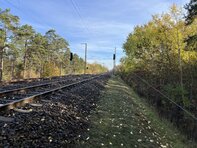
Berlin outer ring gap closure
The completion of ETCS equipment on the Berlin outer ring will close the gaps between the approaching routes. In conjunction with the surrounding projects, this will result in extensive, continuous ETCS operability. As three trans-European corridors run via the Berlin outer ring, the project is of great importance for European rail freight transport.
Project duration
Route data
| Line from | Biesdorfer Kreuz |
|---|---|
| Line to | Golm |
| Kilometers of line to be equipped | 92 km |
| Route number(s) | Contains 40 route numbers |
Planned actions
| ETCS | Level 2 with signals |
|---|---|
| Interlocking(s) | 9 interlockings |
| Scope of equipment |
|
| Planned speed | 120 km/h |
Technologies
Contact
Disclaimer
The dates shown are legally non-binding forecasts based on the current status. The forecasts are in no way intended to establish any kind of legal claim whatsoever that completion will take place by the specified date and that use will be possible. For these reasons, the information should also not be used to make or prepare business decisions, for example, but not conclusively, with regard to the vehicle equipment or the compatibility between the vehicles and the infrastructure. If you have any questions, particularly regarding technical network access or obtaining binding information, please contact your customer advisor.
Most of the infrastructure projects are still in the planning phase, which means that the information provided on these pages reflects the current planning status and is updated regularly.
The Berlin Outer Ring connects all the routes leading to Berlin and enables rail freight transport to bypass Berlin's routes, which are heavily congested with passenger traffic. With a diameter of around 40 km and a length of 125 km, the Berlin Outer Ring has been consistently passable since the 1960s and is the only one of its kind in Europe.
The Berlin Outer Ring is of great importance for European rail freight transport, as it enables connections from Dresden to the Baltic Sea, from Lehrte to Poland or from the North Sea to the Czech Republic. It is therefore also part of the three corridors of the Trans-European Transport Network corridors (TEN-T corridors) North Sea – Baltic, Scandinavian – Mediterranean and Rhine – Danube, which connect Northern Europe with Southern Europe.
Due to its importance in the international rail network, the Berlin outer ring is to be equipped with the standardised European Train Control System (ETCS) in order to enable Europe-wide interoperability in rail freight transport. While the southern Berlin outer ring from Potsdam-Pirschheide to Berlin Eichgestell is already equipped with ETCS as part of the Erkner – Seddin project, the aim of equipping the rest of the ring is to enable continuous ETCS operation. As ETCS is also being installed on the connecting lines to Rostock, Hamburg, Halle/Leipzig, Dresden, and up to the German-Polish border as part of other projects, closing this gap will ensure extensive ETCS coverage.
As part of the European Deployment Plan (EDP) and the Digitale Schiene Deutschland project, the Berlin outer ring is to be equipped with ETCS Level 2 with signals (ETCS Level 2 mit Signale: ETCS L2mS). This means that the route can continue to be used by vehicles that are not equipped with ETCS once the measure has been implemented. The German train control system "Punktförmige Zugbeeinflussung" (PZB) will also remain in operation for this purpose.
Before the project can be implemented, the interlockings along the line must be made ETCS-compatible. Only modern interlockings offer the necessary interfaces, which is why some of the existing interlockings must be replaced with new ones. In terms of equipment, two relay interlockings (RSTW) are currently still in operation. The RSTW in Schönfließ will be replaced by a Simis D generation interlocking from Siemens as part of a corresponding project in the course of the construction of the new ESTW sub-control center (ESTW-UZ) in Birkenwerder. The replacement of the RSTW in Hohen Neuendorf West, on the other hand, is the responsibility of this project. The modern interlocking to be built there will ultimately also be integrated into the ESTW-UZ Birkenwerder (Simis D type). Furthermore, all ESTW in the control area of the ESTW-UZ Hennigsdorf must be replaced by a new generation of interlocking systems, as the Simis C type interlocking systems are not ETCS-compatible. In contrast, the control area of the ESTW-UZ Lichtenberg with Simis D type interlocking systems is already ETCS-compatible.
Parallel to the construction of the interlockings in the ESTW-UZ Hennigsdorf area, the ETCS equipment can already be installed in the control areas of ESTW-UZ Lichtenberg and Birkenwerder, which allows for the bundling of line closures. As a result, the ETCS equipment will be put into operation in several stages, which means that temporary ETCS entry and exit points will have to be set up at the interface between these sections of track.
The infrastructure required for ETCS commissioning must first be installed. This includes balises, which are attached to the sleepers at regular intervals. In addition, ETCS Radio Block Centres (RBC) must be planned and built, which must be connected to the interlockings via new interfaces. Furthermore, ETCS stop markers must be attached to the existing signalling screens to replace the conventional signals in ETCS operation.
The handling of ETCS entry and exit at the borders of the equipment area has high priority. Numerous lines cross the Berlin outer ring and consequently there are many junctions at which ETCS entry and exit points must be set up. However, routes that have already been equipped with ETCS in advance through other projects will be connected seamlessly. In addition, there will be close cooperation with corresponding ETCS measures that are being implemented at the same time. There are corresponding dependencies for the following projects:
- at the boundaries of the control area to the ESTW-A Berlin Eichgestell and Potsdam Pirschheide through the Erkner – Seddin project,
- at Falkenhagener Kreuz through the HLK Hamburg – Berlin project,
- in Hohen Neuendorf through the project Route upgrading Rostock – Berlin (SeRoBe).
Bauende Bahn
This is a Deutsche Bahn project. We are building. So that people can build on us again. More information about the Bauende Bahn can be found here (in German only).



